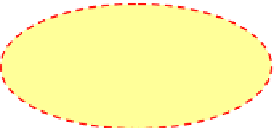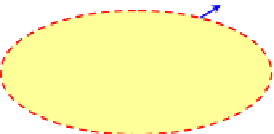Biomedical Engineering Reference
In-Depth Information
(e.g. the transport of maltose in E. coli). Another energy-dependent approach to the uptake of
nutrients is group translocation.
The key factor here is the chemical modification of the substrate during the process of
transport. The best-studied system of this type is the phosphotransferase system. This system
is important in the uptake of many sugars in bacteria. The biological system itself is complex,
consisting of four separate phosphate-carrying proteins. The source of energy is phospho-
enolpyruvate (PEP).
Effectively, the process can be represented by:
Sugar
Þ
þ
PEP
sugar-P
Þ
þ
pyruvate
(10.34)
Þ
/
ð
intracellular
ð
extracellular
ð
intracellular
ð
intracellular
Þ
By converting the sugar to the phosphorylated form, the sugar is trapped inside the cell. The
asymmetric nature of the cellular membrane and this process make the process essentially
irreversible. Because the phosphorylation of sugars is a key step in their metabolism, nutrient
uptake of these compounds by group translocation is energetically preferable to active trans-
port. In active transport, energy would be expended to move the unmodified substrate into
the cell and then further energy would be expended to phosphorylate it.
Certainly, the control of nutrient uptake is a critical cellular interface with its extracellular
environment. In some cases, however, cells can sense their external environment without the
direct uptake of nutrients.
Example 10-4. Escherichia coli uptake of lactose is found to be enzyme assisted. At one point of
culturing in lactose-limiting medium, the lactose concentration in the fermentation broth is
measured to be 0.1 g/L. The lactose consumption rate is determined to be 0.65 g/(L h). If
the maximum volumetric lactose uptake flux is J
Smax
a
¼
1.5 g/(L h) and the corresponding
saturation parameters are given by K
SE
¼
5 mg/L and K
SI
¼
0.2 g/L. Here, a is the specific
surface area of the cells, m
2
/m
3
-culture.
1. Determine the effective concentration of lactose inside the E. coli cell body (biotic phase).
2. Does the result obtained in part (a) make sense and why?
Solution.
Figure E10-4.1
shows a schematic of the lactose transport and reaction process in
the cell. The uptake flux may be computed through Eqn
(10.33)
,or
S
K
SE
þ
S
b
K
SI
þ
J
S
¼ J
S
max
S
(E10-4.1)
S
b
where S is the substrate concentration in the medium (or abiotic phase) and S
b
is the
substrate concentration inside the cell body (biotic phase).
Products
S
S
b
Cell volume: V
C
Cell surface area: A
C
biotic
abiotic
FIGURE E10-4.1
A schematic of substrate uptake and conversion by a cell.









Search WWH ::

Custom Search